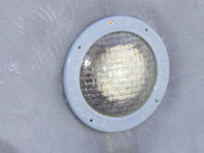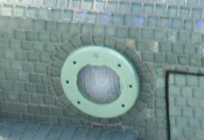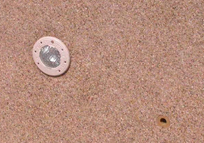Hiding the 'Uglies'
By Paolo Benedetti
 Beyond their ability to hold and circulate water, virtually all concrete watershapes have one more thing in common: Depending upon the size and complexity of the installation, their internal surfaces must be penetrated at a few points (and sometimes at many points) to move water from the vessel to the equipment pad.
Beyond their ability to hold and circulate water, virtually all concrete watershapes have one more thing in common: Depending upon the size and complexity of the installation, their internal surfaces must be penetrated at a few points (and sometimes at many points) to move water from the vessel to the equipment pad.
Each of these penetrations – for main drains, suction and return lines or jets – performs a valuable function. But each and every one of them also interrupts the visual integrity of a watershape's internal surface and creates levels of visual distraction I want to minimize in executing projects for my clients.
And it's not just plumbing: There can be penetrations for lights and other accessories as well, each of them requiring placement of a face ring and attracting what I consider to be unmerited attention. Let's take a brief look at ways of concealing these surface interruptions as effectively as possible.
Hidden Virtues
The trouble with all of these fittings is that suppliers approach them (as is certainly appropriate from their perspective) as one-size-fits-all solutions. They can't make rings in every color of the rainbow, so they head for the least common denominator and use white plastic – or go upscale and make them with chrome or some other metal.
 This all might have sufficed 30 years ago, when most watershape interiors were white and few projects placed any sort of aesthetic demands on these fittings. But today, on a beautiful all-tile finish or with a bold exposed-aggregate surface, these plain-vanilla rings stick out like sore thumbs and compromise the looks of projects in ways I don't want to consider.
This all might have sufficed 30 years ago, when most watershape interiors were white and few projects placed any sort of aesthetic demands on these fittings. But today, on a beautiful all-tile finish or with a bold exposed-aggregate surface, these plain-vanilla rings stick out like sore thumbs and compromise the looks of projects in ways I don't want to consider.
Helpfully, manufacturers are offering more ring treatments these days, and if you're lucky you might find something that approaches a good match with the special finish you've chosen or the beautiful tile your client likes. But more likely you'll need to step in and achieve the look you want by other means.
In many cases, for instance, I will send face rings out to be powder-coated, a process that produces beautiful results in just the colors I desire. Obviously, this adds a bit of time and cost to the process, and you need to take care when you get the rings back not to scratch them during handling or installation (although you do need to scratch them at the screw points to ensure connection to the bonding system). But for years now, powder coating has gotten me the colors I need for a wide variety of situations.
 Another option is the tray approach offered by a few suppliers of suction covers. Here, at the time of finish application, you slather the fitting with the material with which you've finished the rest of the surface – exposed aggregate, pebbles or plaster. And you can even insert tile, although you need to appreciate the importance of getting everything aligned so the tile on the cover continues the patterns seen on the surfaces surrounding it.
Another option is the tray approach offered by a few suppliers of suction covers. Here, at the time of finish application, you slather the fitting with the material with which you've finished the rest of the surface – exposed aggregate, pebbles or plaster. And you can even insert tile, although you need to appreciate the importance of getting everything aligned so the tile on the cover continues the patterns seen on the surfaces surrounding it.
I know that none of these solutions is perfect. For all I do to hide these things well, they'll still be perceptible because they bring dark spots and voids to the surface that can easily draw attention. Still, I take heart in the fact that they are underwater and absolutely do not stand out like the intrusive spa-side controls we discussed last time. They may still be there, but I consider my job done if I make these necessary fittings as minimally noticeable as possible.
In all of this, I'm driven by the fact that I don't like to compromise, especially given the fact that anything I do with respect to in-pool fittings is a bit of a compromise in and of itself. So I'm particular: If the powder color isn't right the first time and things don't look the way I want them to, I'll send the rings back for another round.
I do so because the key for me is covering my traces as best I can. I want my clients to bask in the glory of the whole setting, and the best way I've found to do so is by leaving them with as few visual tripping points or distractions as possible.
